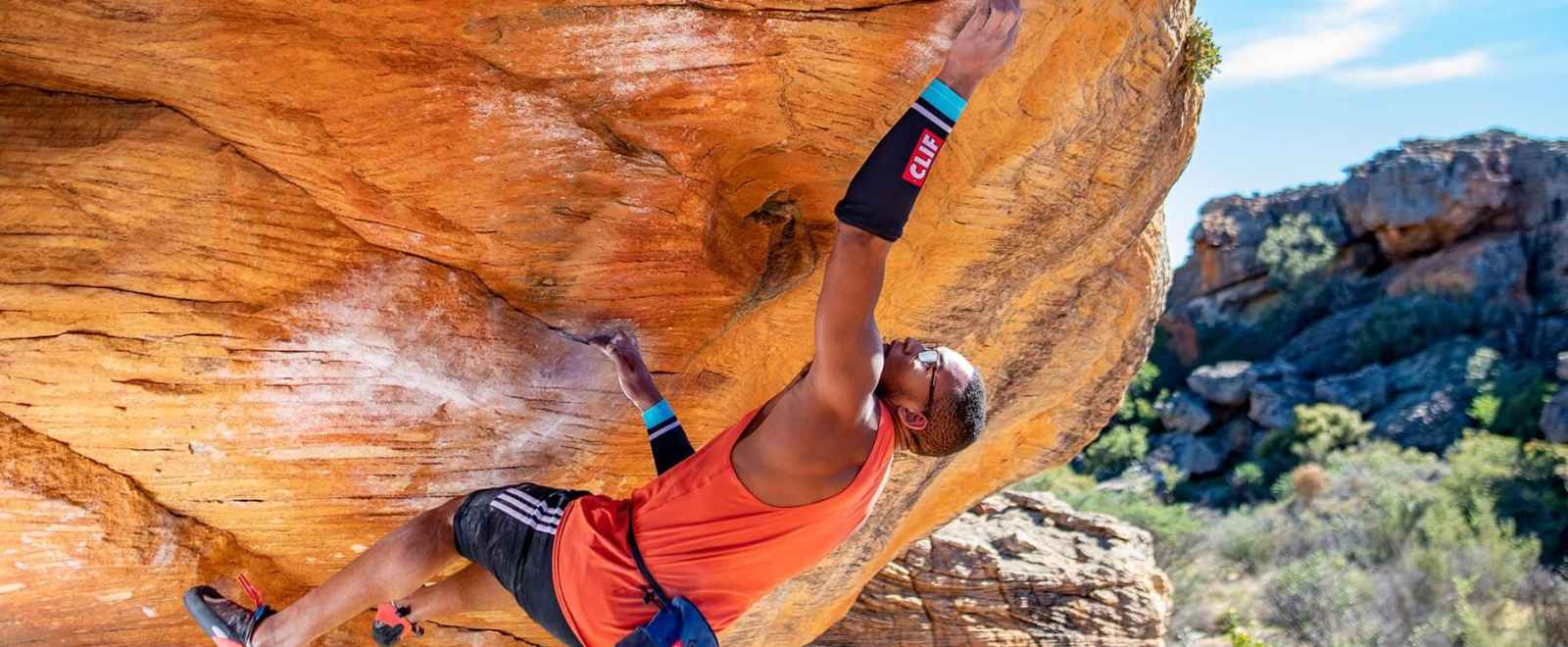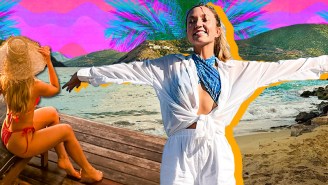The first time Olympic hopeful Kai Lightner walked into a climbing gym, he was six years old. The visit was suggested by a teaching colleague of his mother’s after she needed help getting him down off a 50-foot flagpole he’d shimmied up at school.
“I got in a lot of trouble for climbing up on things that I wasn’t supposed to,” says Lightner, laughing on an IG Live with Uproxx from Salt Lake City. “I grew up with ADHD and I couldn’t stay focused on the games that everyone else was playing. But for some reason when I started climbing, everything clicked — I could spend hours figuring out a route.”
These days Lightner is being encouraged to ascend, both literally and in the culture of his sport. The 21-year-old has racked up 12 national championship titles, recently filmed a “got milk?” commercial made by Free Solo director Jimmy Chin, and is aiming to compete in the 2024 Summer Olympics.
We spoke with Lightner from the national selection / preview event in Salt Lake City to talk training, snack attacks, and bringing climbing into the next generation.
How early did this climbing obsession begin?
I have been climbing up on things since I was a kid. I used to climb over my baby gates. And when I was four, I would eat my lunch up on top of our basketball hoop. I would go up the beam and sit in the net. My first time stepping into that gym at six, I will never forget there was a wall with a massive overhang with a piece of purple tape on it. It was the only wall in the facility that I couldn’t get up.
I was so angry that I started crying while hanging off of it, and I didn’t want to let go until I beat it. I was probably up there for 15 minutes before they were able to pry me off. I came back every day for the next week trying to do that climb, until I finally made it to the top. I think at that point everyone around me realized my dedication and passion for the sport. They decided to get me into the competitive team, and it’s been upward since that.
Given that you started doing competitions so early, and those were indoor events, what was the first time that you made it outdoors to climb?
I had won a few national championships before I did my first real climb outdoors. One of my friends in the scene would make fun of me because I was spending all of this time climbing on plastic, but I had never been on a real mountain. I will admit that I was scared during the first experience. I was only about 10 years old.
The moments indoors are smaller, and, in a way, more intense. The environment is clearly different, there is more to enjoy outdoors and you have the time to do it if you want. It is much more calming, and there is a beauty that comes with that. It has become a really important part of my life now, and I make the time to do both throughout the year.
Starting at such a young age, what did your classmates in school think of your climbing?
Growing up my friends thought that me being a climber was really weird. They didn’t really understand it. I get it though, because we never really saw rock climbing, except maybe in commercials. And usually those were of smiling white families with their dogs. It just seemed like a “white people sport”.
So back home in North Carolina, my friends were curious why I didn’t try something that was more “normal”. I will never forget being in the 2nd grade and having one of my teachers saying it was strange that I climbed rocks, and that because I was so tall I should play basketball. For most of my family, they just didn’t really get it either.
Do you remember when your friends and family really started to take the sport and your career as a climber seriously?
I did a segment for the Today Show, and I remember a lot of kids in my classes coming up to me. They were shocked both that I was still climbing and that I was getting that kind of attention. There was a lot more respect once moments like that started happening, and I even got a few of them to go to the climbing gym with me.
I think that it is very important to see more people that look like you, or who are from your community. Especially that younger generation, because that is how you open those mental doors and provide new pathways when they are still possible. I have a lot of people in my circle who are now trying to rock climb and get outdoors more.
Who do you look up to in the sport of climbing, and in sports in general?
I look up to Adam Ondra tremendously as far as the sport is concerned. He’s probably the best climber in the world, and has the same kind of body type as me, I would say. As far as other sports are concerned, watching LeBron James play basketball is pretty special. Or watching Usain Bolt hit a track. Or watching Simone Biles do a routine. These are all ground-breaking athletes that are paving their own way.
Rock climbing being added to the Olympics made a lot of waves. What did you think when you first heard it announced?
There was a mixed reception in the climbing community about it. Back when I first started climbing, there wasn’t even a thought of that being a possibility. Personally, I see it as an amazing opportunity to represent the sport I love at a whole new level. I have loved watching the Olympics as an event over the years, it is something that I look forward to.
Once that announcement was made how did your training and focus change?
The format for the Olympics is different than any other event that happens in our sport. There are three different disciplines of climbing, including lead climbing where you are hitting large walls with a harness, bouldering where you are hitting smaller walls with somewhere between seven to nine moves with no rope, and then speed climbing where everyone hits the same wall while timed.
These disciplines are commonly individual. And it is unique that the Olympics are combining scores from all three disciplines to get the final numbers and awarding medals based on those. This is extremely physically demanding — because many athletes are having to get into one or two of the disciplines for the first time, truly. I have typically been a boulderer, so training lead climbing and speed climbing has been interesting. It has made me a better overall climber.
How much are you training these days?
I typically speed six hours a day in the gym, five days a week. That consists of two hours of climbing, an hour of core work, conditioning training, and a lot of stretching. The challenging thing about climbing is that it is not just one motion that you do over and over again to perfect, it is constantly changing. We are always traveling to different gyms or parts of the world to compete. So especially these days it requires a lot of workouts and a very diverse style of training.
I find leg day one of those elements that I have to really force myself to do. The sport has progressed a lot, and become more physically challenging. Back in the day, I could get away with not doing a lot of leg training because they are strong already, but with everything that we are putting them through it has become more and more necessary.
Do you listen to anything while you climb?
I am a huge music fan. I will listen to artists like Drake or Lil Baby. It helps me climb better and get psyched. If you see any photos of me in a competition, I definitely have my headphones on. You aren’t allowed to climb with music while you are on the wall. I like the Bose headphones. They stick to my head nicely. I like having ones that wrap around the head because the wireless ones can sometimes fall and get damaged.
What are you eating during all of these workouts?
Since I’m training for most of the day it is critical to have snacks and drinks around at the gym. I start my day off with a glass of milk, before I hit breakfast. it gives me potassium, the protein for the muscles, and the sustenance I need. I keep some at the gym as well to crack open when I need another boost.
I also like to have Clif Bars [one of Lightner’s sponsors] around for the carbohydrates and the energy that I need on the wall. Food is important not just to keep you fueled but it can be a great motivator as well in that situation. I try to have a general diet that is high in protein and constantly changing to keep it interesting.
Speaking of milk you recently shot an ad for them with the great Jimmy Chin.
It was great working with Jimmy Chin. As you can imagine, we had a lot of mutual friends. Such an amazing cinematographer. It was amazing to get to meet him finally, especially with how beneficial he has been for our sport for his projects like Free Solo. He is a storyteller who has the ability to tell the story the right way because he is a climber.
The project was very cool, and it felt so natural because I drink milk every day. It felt like another great way to promote the sport as well. I used to get in trouble for climbing up on the sides of buildings, and my mom would yell at me to get down. So getting to climb on this huge building in Kansas City, not just getting to, but being asked to, was amazing.
Let’s talk about how accessible climbing is these days. I just went to Vital which is an impressive new facility in Brooklyn. What has it been like watching its expanse?
I heard about that one! The facilities are there, I think almost every metropolitan area has a climbing gym established or being established these days. You can catch a metro or another public transportation and be there in no time. II like seeing it more prevalent in these communities of color. I think it will only get bigger.
I feel like that sport is still seen in a very specific light, with people picturing hippies living out of vans. So the idea of inner-city kids excelling at it, eventually in forums like the Olympics, would be impactful for the all-around perspective I believe. And to be a part of that is a huge honor.
What is your plan for the Olympics?
I have set my sights on the 2024 Olympics. I decided to go to school for a degree first. So I missed out on this year’s event. I am actually here in Salt Lake City right now for some national cups and for team selections. It is really exciting for me to get one step closer in that process. Being a part of it would be a dream come true.
‘Behind the Wall’ highlights Jimmy’s inspiration for the film and all the thought and detail that went into making his vision a reality. That reality included elite climber Kai Lightner, who has not only made a name for himself in the sport, but also has taken on a mission far greater: working to readdress the racial inequity in climbing through his organization, Climbing 4 Change. got milk? is proud to help Kai inspire the next generation of climbers by becoming a gold level sponsor.







